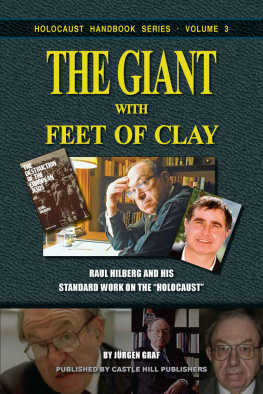Jrgen Graf
The Giant
with Feet of Clay
Raul Hilberg
and his
Standard Work
on the
Holocaust

Castle Hill Publishers
P.O. Box 243, Uckfield, TN22 9AW, UK
2nd edition, January 2015
HOLOCAUST HANDBOOKS, Volume 3:
Graf, Jrgen:
The Giant with Feet of Clay. Raul Hilberg and his Standard Work on the Holocaust
2nd, slightly corrected and updated edition; translated by Michael Humphrey
Uckfield, East Sussex: Castle Hill Publishers
PO Box 243, Uckfield, TN22 9AW, UK
January 2015
ISBN10: 1-59148-078-7 (print edition)
ISBN13: 978-1-59148-078-5 (print edition)
ISSN 1529-7748
The first edition of this book (ISBN 0-9679856-4-1) appeared in March 2001, published by Theses & Dissertations Press, Capshaw, AL, a subsidiary of Castle Hill Publishers
Original German edition: Graf, Jrgen: Riese auf tnernen Fen. Raul Hilberg und sein Standardwerk ber den Holocaust,
Castle Hill Publishers, October 1999, ISBN 1-902619-02-1
1999, German edition by Jrgen Graf
2015, by Castle Hill Publishers, https://shop.codoh.com
Body text printed in Times New Roman, 11 pt. Throughout this book, double quotation marks () are used for quotations (set always in italics), single marks () for otherwise non-emphasized text of so-called and so-to-say character (except when used for quotations inside quotations). Quotations are introduced once with a single -mark and ended with a -mark (to break with the American tradition to introduce every paragraph in a quotation with a -mark, but never closing it, which, strictly speaking, is an unterminated string error). Entire sentences or paragraphs of quoted text are rendered in 10 pt font and left indentation. Any addition to quoted text is rendered non-italic and surrounded by [brackets], so are added omission ellipses [], which could otherwise not be distinguished from ellipses in the original. Titles of books and journals are set in italics without quotation marks. References have the order: a) books: author(s)/editor(s), title, [volume,] [edition,] [publishing house,] town year[, pages]; b) journals: author(s), [title of article], name of journal, volume[(issue)] (year)[, pages] (items in brackets optional). All references to the original English version of Hilbergs book were added by the translator.
Set in Times New Roman.
www.HolocaustHandbooks.com
If this site inaccessible, try an anonymizing website.
Table of Contents
You saw, O king, and behold, a great image. This image, mighty and of exceeding brightness, stood before you, and its appearance was frightening. The head of this image was of fine gold, its breast and arms of silver, its belly and thighs of bronze, its legs of iron, its feet partly of iron and partly of clay. As you looked, a stone was cut out by no human hand, and it smote the image on its feet of iron and clay, and broke them in pieces; then the iron, the clay, the bronze, the silver, and the gold, all together were broken in pieces, and became like the chaff of the summer threshing floors; and the wind carried them away, so that not a trace of them could be found. But the stone that struck the image became a great mountain and filled the whole earth.
Daniel 2:31-35 (RSV)
I. Introduction
According to the official version of history, during the Second World War the German National Socialists carried out a mass murder against the Jewish population that was unparalleled in its monstrousness and its systematic ruthlessness. Many millions of Jews, we are told, were taken from German-ruled lands and packed off to extermination camps in the Polish territories and there killed, mostly in gas chambers but some in gas vans. We are also told the Germans massacred an immense number of Jews behind the eastern front. The total number of victims of gassing or shooting as well as of those who died from disease, exhaustion, hunger or other cause supposedly runs to five or six million.
This claimed unique genocide is usually labeled with the word Holocaust, which comes from the Greek word o s for entirely burned , and which has spread throughout and beyond the Anglo-Saxon language domain since the release of the US motion picture of the same name in 1979.
The version of the fate of the Jews during the Second World War just summarized can be found in all the dictionaries and history books of the Western world. It is taken as axiomatic in any public discussion on the Holocaust. Deviation from this version is discouraged. Dissenting voices are stilled by a powerful media censorship and in many European states they are suppressed with police-state terror tactics.
In the last few decades a vast literature on the Holocaust has appeared, but there is general agreement that there is one work which can be regarded as the standard work on the subject: Raul Hilbergs The Destruction of the European Jews .
Born in Vienna in 1926, the Jew Hilberg emigrated to the United States with his parents in 1939. In 1944 he joined the American Army. In 1948 he began to study the question of the destiny of the Jews under the National Socialist regime. In the years 1951/52 he worked in the Federal Documentation Center at Alexandria, Virginia, where his job was to evaluate captured German documents. In 1952 he was awarded a Masters degree in Political Science, and in 1955 the Doctors degree in Law. As is the case with most other authors who have dealt with the Holocaust, he is not a historian by profession. However, for many years at the University of Vermont, in addition to International Relations and US Foreign Policy he has taught on the history of the Jews during the Second World War.
The Destruction of the European Jews first appeared in 1961 and was reprinted unchanged in 1967 and 1979. In 1985, a revised and definitive edition with a few changes followed. Amazingly, the voluminous work was not published in German until 1982, and then only by a small publisher (Olle and Wolter in Berlin). It was called Die Vernichtung der europischen Juden . We will use the three-volume edition published May 1997 by Fischer Taschenbuch Verlag in Frankfurt, based on the definitive English version of 1985.
Hilbergs study on the Holocaust claims to be the unrivalled best and most exhaustive work of its kind. This is made unmistakably clear in the introduction to the German edition of the work:
If the phrase standard work has any meaning at all, Hilbergs famous comprehensive history of the Holocaust must be considered as such. [] The theme of this work is the malefactors, the plan, the method of operation and the operation itself. With the coolness and precision which characterizes the great historians (Sddeutsche Zeitung) Hilberg traces the involvement and participation of the ruling elites in the government, in industry and the armed forces in the destruction of the Jews. The functional dedication of the ordinary bureaucrat, railway man, policeman and soldier to the work of annihilation will also be traced. A type of criminal steps forward (who will be named) who will never stand before a judge after 1945: the Prussian general, the national conservative ministerial official, the diplomat, the jurist, industrialists, chemists and medical doctors.
Hilberg has collected and refined the material for his book throughout his lifetime. He is known as the best-informed specialist on the sources, which for the most part came from the perpetrators. They have recorded the proof of their deadly handiworkwith characteristic thoroughnessa hundred thousand times overwith official stationery and seals.
The present comprehensive history of the Holocaust is source material for specialists, analysis for theoreticians and a history book without parallel for the general public. (Sunday Times).








